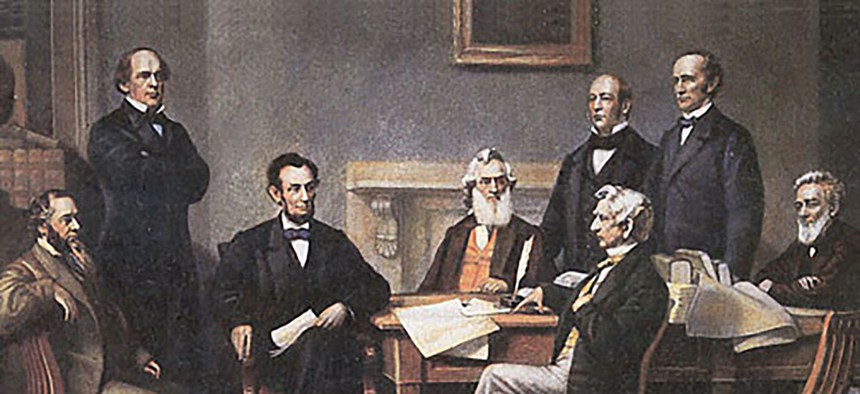Would Hillary Clinton Appoint a 'Team of Rivals'-Style Cabinet as President?
It would go a long way toward healing a nation.
The aggregate polls tell us that Hillary Clinton is likely to decisively beat Donald Trump on Nov. 8 and become the United States’ next president. What they—and almost all analysts—fail to prescribe is how she will govern after a quarter-century of obstructionist partisan rancor and the ugliest national election in modern American history.
As a starting point, a rationalist might suggest that Clinton (if she wins) will attempt to rise above the extraordinary political animus by convening the equivalent of a “war cabinet”: a willing coalition with members of both major parties intent on putting the nation on a healing track.
One can easily imagine, for example, former secretary of state Colin Powell, former New York mayor Michael Bloomberg, and maybe even senator Susan Collins of Maine serving in a Clinton administration. With their input and a bit of cooperation, Democrats and Republicans conceivably could hammer out deals on the economy, health care, climate change and gun violence, and perhaps even move on to a united strategy on the wars in the Middle East.
But such a concession by Clinton appears improbable. Neither does it seem likely that the presence of these Republicans—nor perhaps any Republican—in her cabinet would attract the policy support of the bulk of their party members in Congress.
The real “Team of Rivals”
In the US, the practice of bringing together bitter political enemies for the good of the country dates back to George Washington, the first and only nonpartisan US president. He invited both Alexander Hamilton and Thomas Jefferson into his cabinet despite their very different visions for the fledgling democracy. (Hamilton, a northerner, was a Federalist; Jefferson would go on to form the Democratic-Republican party, a Southern grouping in the early 1800s.)
The “Team of Rivals” chronicled by Doris Kearns Goodwin in her 2005 biography of Abraham Lincoln has helped to fuel our modern fantasies of bipartisan cooperation. But in Lincoln’s case, the rivalry was strictly intra-party; the men who agreed to join his cabinet as the nation devolved into civil war had been Lincoln’s fiercest competitors for the Republican nomination in the election of 1860.
If Clinton has rivals in her cabinet, they will be assembled in the style of Lincoln’s, as an attempt to defuse still-raw tensions within the Democratic party, analysts say. While Clinton will be instinctively drawn to appoint Democratic centrists, she will somehow have to appease her left-wing Democratic rivals, senators Bernie Sanders and Elizabeth Warren, who have supported her while also protecting their own progressive agenda.
Matthew Dallek at George Washington University says Clinton’s cabinet, like US president Barack Obama’s, is likely to be “highly diverse and include lots of women, African-Americans, and Latinos.” She may appoint a couple of Republicans as well, he says.
But in terms of restoring a working relationship between the parties, that won’t be decided in the cabinet. “I don’t think her cabinet appointments are going to have much if any impact on whether or not the country will have gridlock,” Dallek says.
Instead, peace will have to come in the give and take of Congress.
Right now, that’s looking like an especially tall order for Republicans in the legislature, who will first have some work to do putting their own house in order.
“The Republican party has a real mess on its hands,” says Mark Peterson, a political science professor at UCLA. “There is an enormous divide between much of its a base and a substantial part of its intellectual elite, leadership, and past participants in actual governance in previous administrations. There are also a number of deeply conflicted elected officials at all levels who felt they could not abandon their party’s nominee but who would not ever had made that selection themselves, and they have tied themselves in knots trying to identify a survival strategy. It is still unclear how these divisions will get resolved.”
The safe bet: When the party is not chewing itself up in internecine conflict between its establishment, Trumpian, Freedom Caucus, and Tea Party wings, it will be at daggers drawn with Clinton.






